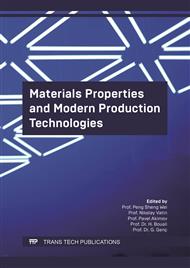[1]
Gontar, Yu.V., Chalova, A.I., Gainutdinov, A.K.: Gypsum and gypsum anhydrite mortar mixes for finishing works. Building materials 7, 6-7 (2006).
Google Scholar
[2]
Belyaev, E.B.: On the development of the Russian market of dry building mixtures. Building materials, equipment, technologies of the XXI century 11, 18-19 (2002).
Google Scholar
[3]
Bouzit, S., Laasri, S., Taha, M., Laghzizil, A., Hajjaji, A., Merli F., Buratti C.: Characterization of Natural Gypsum Materials and Their Composites for Building Applications. Applied Sciences 9(12), 1-15 (2019).
DOI: 10.3390/app9122443
Google Scholar
[4]
Buldyzhova, E.N., Galtseva, N.A., Buryanov, A.F., Petropavlovskaya, V.B.: Technical-economic and Environmental Aspects of Production and Application of Gypsum Materials and Products. Actual problems of modern science, technology and education 2(71), 197-200 (2013).
Google Scholar
[5]
Popov, K.N., Caddo M.B.: Building materials and products. High school, Moscow (2002).
Google Scholar
[6]
Tumuklu, A., Ciflikli, M., Ozgur Z.: Determination of the Trace Elements Effecting the Color of the Gypsum Mineral. International Journal of Engineering Research and Management 3(09), 16-19 (2016).
Google Scholar
[7]
Klimenko, V.G.: Influence of modifying composition of gypsum binders on the structure of composite materials. Journal of Physics: Conference Series. 1118(1), 43285 (2018).
DOI: 10.1088/1742-6596/1118/1/012019
Google Scholar
[8]
Galceva, N.A., Burianov, A.F., Soloviev, V.G., Tkachenko, D.I.: A Modified Binder on the Basis of Synthetic Anhydrite for Stowing Mixtures. Construction materials 7, 74-76 (2017).
Google Scholar
[9]
Gal'tseva, N.A., Bur'yanov, A.F., Buldyzhova, E.N., Solov'ev, V.G.: The Use of Synthetic Calcium Sulfate Anhydrite for Production of Filling Mixtures. Construction materials 6, 76-77 (2015).
Google Scholar
[10]
Galtseva N.A., Buryanov A.F., Buldyzhova E.N., Morozov I.V.: On the question of using synthetic anhydrite in dry mixtures. In: Collection of reports of the All-Russian scientific conference, p.47–52. BSTU V.G. Shukhova, Belgorod (2020).
Google Scholar
[11]
Buryanov, A. F., Gontar, Yu.V., Chalova, A.I. On the question of using gypsum and anhydrite binders in dry mixtures for the device of floor bases. Dry mixes 1, 11-13 (2010).
Google Scholar
[12]
Buryanov A.F., Petrachenko, V.V.: The influence of additives on the hydration of anhydrite binding. In: Increasing the efficiency of production and use of gypsum binders and products: materials of the All-Russian seminar with international participation, pp.209-217. Publishing house Alvian,, Moscow (2006).
Google Scholar
[13]
Edamenko, A.S., Matveeva, L.Yu., Yastrebinskaya, A.V.: Influence of Gypsum Binder Phase Composition on Operational and Mechanical Properties of the Hydration Product. Solid State Phenomena 299, 1086-1090 (2020).
DOI: 10.4028/www.scientific.net/ssp.299.1086
Google Scholar
[14]
Alfimova, N. I., Pirieva, S. Yu., Elistratkin, M.Yu., Nikulin, I. S., Titenko, A.A.: Binders from gypsum-containing waste and products based on them. IOP Conf. Series: Materials Science and Engineering. 945, 012057 (2020).
DOI: 10.1088/1757-899x/945/1/012057
Google Scholar
[15]
Cánovas, C.R, Macías, F., Pérez-López, R., Basallote, M.D., Millán-Becerro, R.: Valorization of wastes from the fertilizer industry: Current status and future trends Journal of Cleaner Production 174, 678–690 (2018).
DOI: 10.1016/j.jclepro.2017.10.293
Google Scholar
[16]
Rashad, A M.: Phosphogypsum as a construction material. Journal of Cleaner Production 166, 732–743 (2017).
DOI: 10.1016/j.jclepro.2017.08.049
Google Scholar
[17]
Kharitonov, A., Smirnova, O.: Optimization of repair mortar used in masonry restoration. Spatium 42, 8-15 (2019).
DOI: 10.2298/spat1942008k
Google Scholar
[18]
Buryanov, A.F., Kolkataeva, N.A.: Prospects for use of gypsum and anhydrite binders for floor screws. Stroykompleks-2008, 160-163 (2008).
Google Scholar
[19]
Rashad, A M.: Phosphogypsum as a construction material. Journal of Cleaner Production 166, 732–743 (2017).
DOI: 10.1016/j.jclepro.2017.08.049
Google Scholar
[20]
Meshkov, P. I., Mokin, V. A..: Methods for optimizing the composition of dry building mixtures. Building materials 5, 12-15 (2000).
Google Scholar


